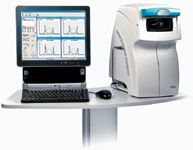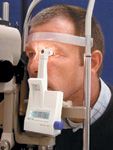Article
Newer methods of evaluating IOP emerge, call for validation
Minneapolis-Alterations in corneal properties in both keratoconus and Fuchs' corneal dystrophy can affect the accuracy of Goldmann tonometry, highlighting the importance of validating newer methods of measuring IOP and of further studying the metrics of corneal biomechanical properties, according to Jeff Sanderson, MD, an ophthalmologist in private practice in Minneapolis.

"The cornea has a large influence in interpretation of IOP, but Goldmann applanation tonometry, the current gold standard for measuring IOP, is flawed by alterations in corneal biophysics, both iatrogenic and pathologic," Dr. Sanderson said.
Refractive surgery causes changes in corneal structure that can affect measurement of IOP, as can corneal pathologies such as keratoconus, Fuchs' dystrophy, and penetrating keratoplasty.

In a study conducted earlier this year while he was a fellow at the Pepose Vision Institute in St. Louis, Dr. Sanderson and colleagues evaluated factors other than central corneal thickness (CCT) that affect IOP. They compared IOP and corneal biomechanical parameters in eyes with keratoconus and Fuchs' corneal dystrophy with pachymetry-matched normal control eyes using Goldmann applanation tonometry (GAT), the Ocular Response Analyzer (ORA, Reichert), and the Pascal Dynamic Contour Tonometer (PDCT, Ziemer).
With these devices they obtained slit-scanning videokeratography, ultrasound pachymetry, and IOP measurements. The mean CCT was 463 μm for the eyes with keratoconus and 585 μm for the eyes with Fuchs' dystrophy.
They also recorded IOP and markers for corneal biomechanical properties such as CCT, ORA corneal hysteresis, ORA corneal resistance factor, and PDCT ocular pulse amplitude.
Results showed that the mean CCT in both keratoconus (463 ± 77 μm) and Fuchs' dystrophy (585 ± 53 μm) was not statistically different from their respective sets of control eyes (488 ± 20 μm, p = 0.32 and 604 ± 20 μm, p = 0.19).
Likewise, IOP measurements in the eyes with keratoconus and Fuchs' dystrophy, measured with the PDCT and cornea-compensated ORA, were not statistically different from IOP measurements in corresponding control eyes (p > 0.10).
Differences existed in other parameters, however. Corneal hysteresis was lower in eyes with advanced keratoconus (7.0 ± 1.4 versus 8.4 ± 1.2 mm Hg for controls, p = 0.03) and in eyes with Fuchs' dystrophy (8.0 ± 2.0 versus 11.5 ± 1.8 mm Hg for controls, p <0.01). Mean corneal resistance factor also was lower in the keratoconus and Fuchs' eyes than in the controls, whereas ocular pulse amplitude was not statistically different among the study and control groups because it is more likely a marker of overall ocular rigidity.
Keratoconus and Fuchs' dystrophy are conditions marked by disparate mean corneal thickness, but this study of corneal biomechanical metrics showed reduced rigidity compared with control corneas of similar thickness, Dr. Sanderson said.
"This demonstrates that metrics of corneal rigidity may not correlate with central corneal thickness, and that corneal biomechanics reflect more than central pachymetry alone," he said.
He added that new methods of measuring IOP are needed to supplement Goldmann tonometry.
"This study confirms that there are alterations in the corneal properties in both keratoconus and Fuchs' dystrophy that can affect the accuracy of Goldmann tonometry," he said.





